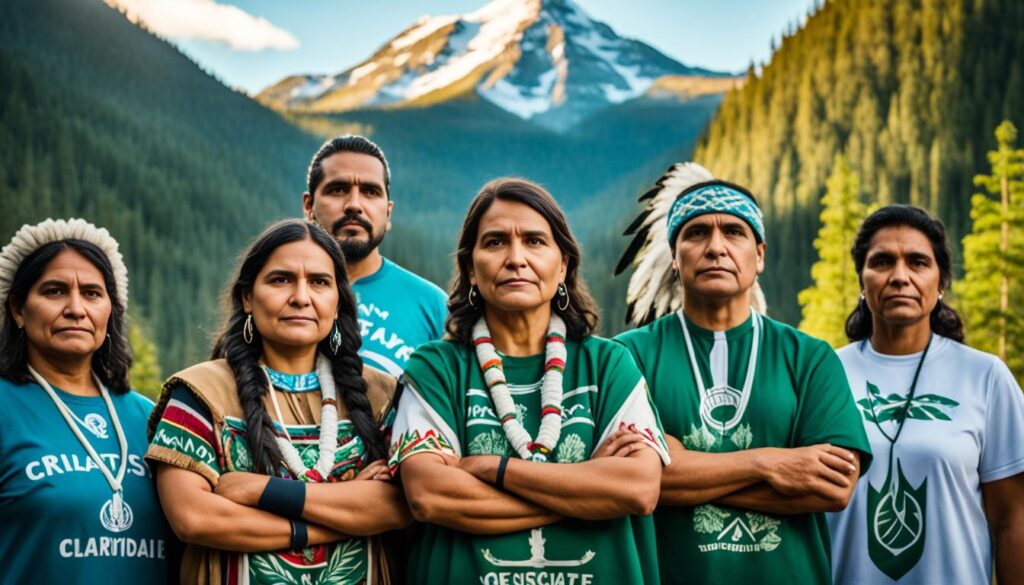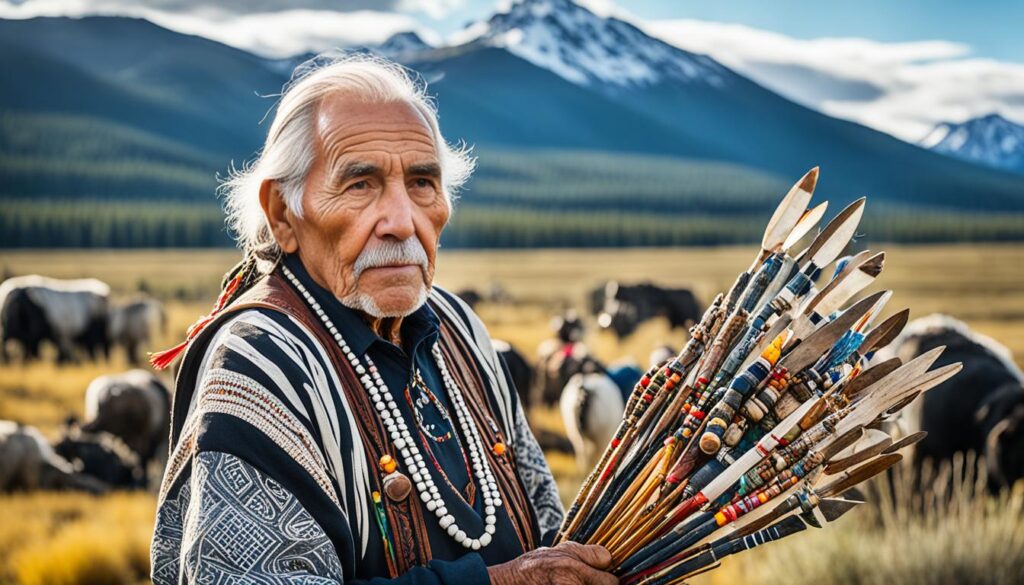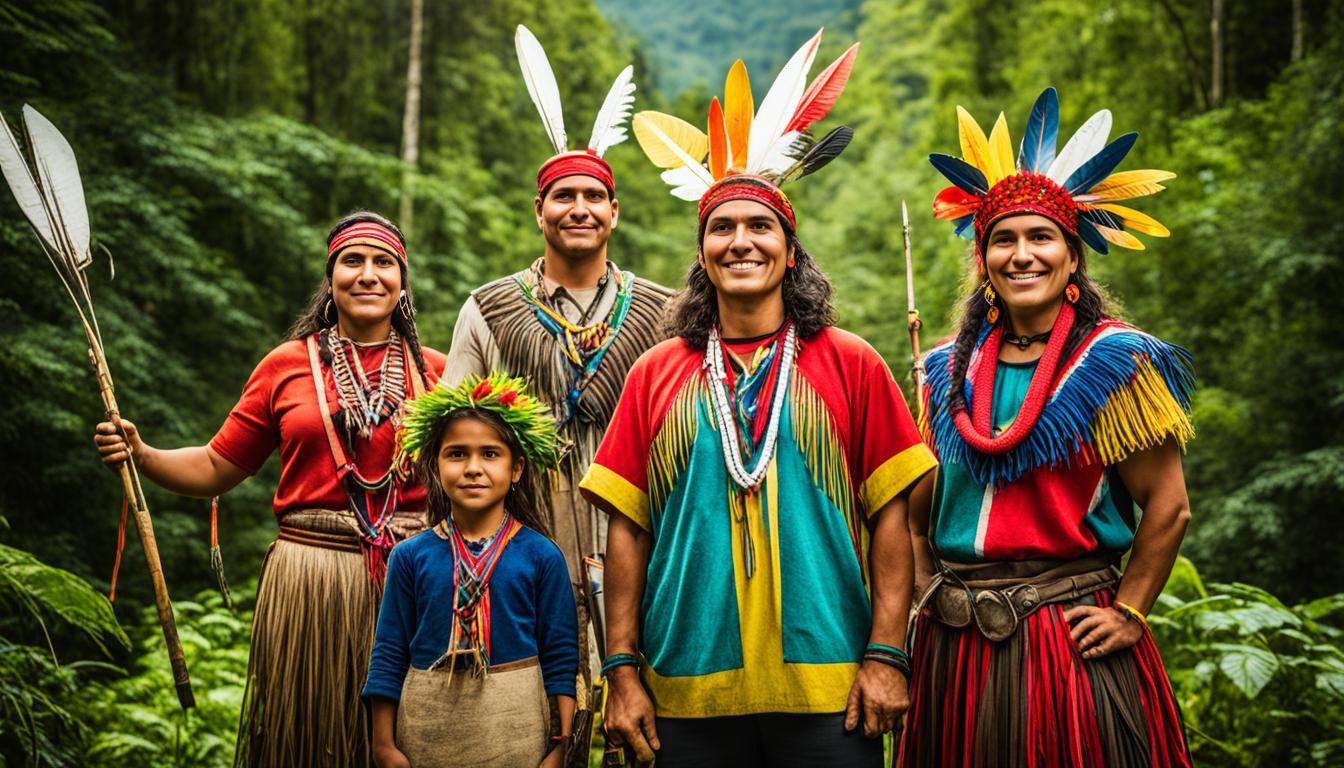In 2007, a big step was taken to help fight climate change. Most countries signed the Declaration on the Rights of Indigenous Peoples. This agreement highlights the key role Indigenous communities have in fighting climate change.
Indigenous peoples have a deep connection to their lands and resources. They have been protecting the environment for many years1. Their knowledge and sustainable ways of living offer great insights on how to deal with climate change threats.
Projects led by Indigenous peoples are showing real results. They’re working on things like reforestation, improving incomes, and managing watersheds. These efforts are backed by groups like the Adaptation Fund and are making a big difference1.
Key Takeaways
- Indigenous peoples have unique knowledge and insights crucial for fighting climate change.
- The 2007 UN Declaration on the Rights of Indigenous Peoples protects their rights to the environment.
- Indigenous-led projects are crucial in the fight against climate change, focusing on things like reforestation and income diversification.
- Working with Indigenous groups helps protect their cultures and traditions from climate change threats.
- Indigenous peoples are leading the environmental movement, using their deep connection to the land for sustainable solutions.
The Importance of Indigenous Knowledge in Tackling Climate Change
Indigenous peoples have a deep connection to their land and resources. This connection gives them valuable insights into the environment and how to adapt to climate change2. They have developed traditional ecological knowledge that can help us find effective climate solutions. This knowledge is key for creating sustainable adaptation strategies that respect their rights and practices.
Connection to Land and Resources
Indigenous communities understand the environment in a unique way. They see the world as a complex web of relationships between humans, nature, and the cosmos2. This deep bond with the land makes them skilled environmental stewards. They protect biodiversity and keep their ecosystems in balance2.
Custodians of the Environment
About 22% of the world’s land is owned by Indigenous peoples, and it’s home to 80% of Earth’s biodiversity2. This shows how important they are in protecting the environment and adapting to climate change. Their knowledge is vital for fighting climate change because they understand the world in a holistic way2.
Climate change affects Indigenous peoples a lot because they depend on the land for their way of life2. For example, in eastern Canada, rising sea levels have made freshwater salty, threatening their food and traditional medicines2. This highlights why we need to include Indigenous knowledge in our climate action plans.
Indigenous knowledge is key in fighting climate change. Many biodiverse areas are safe thanks to Indigenous efforts and awareness2. Groups like the Indigenous Climate Action (ICA) in Canada help Indigenous communities plan for climate change2. The Pawanka Fund also supports Indigenous resilience by helping them shape policies and fund projects for adapting to climate change2.
“Indigenous knowledge is seen as crucial for climate change resilience due to holistic understanding of environmental cycles and human-nature-cosmos interrelationships.”
By valuing Indigenous peoples’ expertise, we can create better climate solutions that respect their rights and traditions2. Working together, like with tribal advisory boards, is important to make sure their views are heard and respected in climate adaptation efforts3.
Adaptation Fund Projects: Empowering Local Communities
The Adaptation Fund leads in supporting climate adaptation projects for local Indigenous communities worldwide4. In the Ecuador-Colombia border, it helped Afro and Awá communities restore over 8,000 hectares of forest. This boosted food security and used ancestral knowledge in adaptation efforts4. Such projects show the importance of valuing and using Indigenous practices for climate resilience4.
Restoring Forest in Ecuador and Colombia
The Adaptation Fund has supported projects to restore forests and ecosystems with Indigenous communities. In the Ecuador-Colombia border, it funded a project with Afro and Awá communities to reforest over 8,000 hectares4. This effort not only stored carbon but also enhanced food security and livelihoods for locals4.
Incorporating Ancestral Knowledge
The Adaptation Fund’s strategy includes using ancestral knowledge and traditional practices in climate adaptation4. By partnering with Indigenous communities, these projects use ancient wisdom on sustainable land use and ecosystem preservation4. This approach leads to more effective and culturally suitable solutions for climate change.
“The Adaptation Fund has been applying locally led adaptation principles for over a decade4, and the fund established an Enhanced Direct Access funding window in 2021 to further empower local communities.”
The Adaptation Fund’s focus on respecting and using Indigenous knowledge and practices is key to its climate adaptation strategy4. Projects like the one in the Ecuador-Colombia border show the strength of community-led solutions to climate change challenges4.
Indigenous Peoples Stepping Up Climate Action
Indigenous peoples around the world are now using the courts to push governments to act on climate change5. The Wet’suwet’en First Nation in Canada is a prime example. They sued the government, saying climate change is harming their lands and way of life5. This lawsuit is part of a bigger movement where Indigenous groups are fighting for their rights and the planet.
Wet’suwet’en Lawsuit Against Canadian Government
The Wet’suwet’en lawsuit is a big step in fighting climate change5. Indigenous communities, who have always protected the land, are now using the law to safeguard their rights and the environment5. This case shows how crucial Indigenous knowledge and leadership are in solving the climate crisis.
Indigenous-led climate lawsuits are becoming more common5. Across the globe, Indigenous groups are suing governments. They say climate change is damaging their traditional lives and violating their human rights5. These lawsuits are key in making governments take action and listen to Indigenous voices in the climate fight.
More Indigenous-led climate lawsuits show how vital Indigenous knowledge and leadership are in fighting climate change5. Traditional ecological knowledge can lead to sustainable solutions. Indigenous-led efforts ensure climate policies respect local communities’ rights and interests5.
As the climate crisis worsens, Indigenous peoples are playing a key role in fighting climate change5. Through legal battles, grassroots activism, and sharing traditional knowledge, they’re leading the charge to protect the planet. They’re working towards a sustainable future for everyone5.
A New Frontier in the Environmental Movement
Experts say the rise of indigenous climate litigation marks a new chapter in fighting for the environment. By the end of 2022, over 2,100 climate-related cases were filed worldwide, more than in 20176. These cases often focus on human rights, with Indigenous groups fighting for their culture and way of life.
Rising Tide of Climate-Related Court Cases
There’s a big increase in indigenous climate litigation. Marginalized communities are now using the law to fight climate change’s effects. Indigenous peoples, often hit hard by environmental damage, are going to court to save their lands and traditions6.
This legal push could change how we deal with climate change. It makes governments and big companies answer for their actions. These cases highlight the importance of Indigenous knowledge in solving our environmental problems.

“Indigenous peoples are on the frontlines of the climate crisis, and they are fighting back through the courts to protect their rights and their lands. This is a new frontier in the global environmental movement, and it has the potential to drive real change.”
– UN Environment Programme official
Overcoming Legal Hurdles and Challenges
Indigenous peoples often face big legal challenges in their climate lawsuits. Courts often say they don’t have the right to sue because they didn’t show they were directly harmed by climate change7. They also struggle because they don’t have official indigenous land rights without titles, which many don’t have7. Plus, environmental defenders from these communities face violence and threats for fighting for their rights and the planet8.
Despite these big obstacles, Indigenous peoples are finding new ways to fight back and protect their rights. They use international human rights laws, like the United Nations Declaration on the Rights of Indigenous Peoples, which talks about self-determination and land rights7. They’re also taking their cases to domestic and regional courts and winning some big victories.
In 2021, the Yurok Tribe in California sued the federal government. They said the government wasn’t doing enough to stop climate change, which broke their constitutional rights and treaty promises9. This case is still going, but it shows a trend of indigenous-led climate litigation. It’s about making governments and companies take responsibility for their actions.
Indigenous communities are also working hard to get their land rights officially recognized. They’re pushing for laws like the Indian Child Welfare Act in the U.S., which was made in 1978 to stop the forced removal of Native children from their families7. With these laws, they can better protect their land and natural resources from harm.
| Legal Challenges Faced by Indigenous Peoples | Strategies to Overcome Hurdles |
|---|---|
|
|
The legal battles faced by Indigenous peoples in fighting climate change are tough. But their strength and resilience keep inspiring change. By facing these challenges and standing up for their rights, Indigenous communities are leading the way to a fairer future for everyone8.
Indigenous peoples give fresh impetus to fight against climate crisis
Indigenous peoples are now leading the charge against the climate crisis10. They make up just 5% of the world’s population but manage over a quarter of the land. This land is home to 80% of the world’s biodiversity10.
Stewards of the Land
Indigenous peoples have a deep knowledge of their lands, gained over centuries11. This knowledge lets them live sustainably. They respect the natural world deeply, making them key allies in fighting climate change11.
As climate change worsens, with more heatwaves and wildfires, Indigenous communities are acting11. They use their traditional knowledge to find new solutions11.
They’re helping communities affected by climate change with sustainable fishing and early warning systems for disasters10. Indigenous peoples are leading the fight against the climate crisis10.
“Indigenous peoples have been the stewards of the land for generations, and their knowledge and experience can provide vital insights and solutions for the global fight against climate change.”
The Paris Agreement sets tough emissions goals, and Indigenous communities are key to meeting them12. By blending traditional and modern methods, they’re crucial for a sustainable future12.

We need to listen to Indigenous peoples more. Their knowledge can help us fight the climate crisis10. As we work to prevent global warming’s worst effects, Indigenous leaders show us the way to a better future10.
The Role of Youth and Social Media
Thanks to the climate crisis, indigenous youth activism is growing fast, thanks to social media. Emmanuela Shinta, from the Dayak Indigenous community in Indonesia, started the Ranu Welum Foundation. It uses old knowledge and new tech to protect forests. Naelyn Pike, a 21-year-old Apache activist, teaches people online about Indigenous rights and the climate crisis. These young Indigenous leaders are making their communities heard and getting people to act13.
Emmanuela Shinta and Ranu Welum Foundation
Emmanuela Shinta, a young Indigenous woman from Indonesia, leads the fight against climate change. She started the Ranu Welum Foundation to save the forests and traditional life of the Dayak people. Shinta mixes her deep indigenous knowledge with modern tech to find new ways to solve environmental problems13.
Naelyn Pike’s Advocacy for Indigenous Rights
Naelyn Pike, a 21-year-old Apache activist, uses social media to spread the word about Indigenous rights and the need for climate action. She teaches her followers about climate change’s effects on her community and how to support local efforts. Her work encourages others to fight for environmental justice and protect indigenous communities13.
These young Indigenous leaders lead a global movement, using new ways to tackle the climate crisis and make their communities heard. Social media helps them reach more people, build connections, and get people to act13.
“Youth engagement in Adaptation Fund projects is driven by factors such as exposure to extreme climatic events, climate change awareness, leadership characteristics, and a readiness to learn and experiment.”13
The growing climate-related activism by Indigenous youth shows the strength of grassroots movements. Young people are key in the environmental fight. By using social media, these leaders spread their communities’ messages and bring about real change14.
Representation at Global Climate Negotiations
At the 2021 United Nations Climate Change Conference (COP26), a big step was taken to boost the voices of indigenous communities in climate talks15. Twenty-eight indigenous leaders were chosen to be “knowledge holders” and share their unique views with governments15. This move highlighted the crucial role of civil society, including youth and indigenous peoples, in fighting the climate crisis.
Indigenous communities have always fought against climate change, using their deep knowledge and sustainable ways16. But, they’ve often been left out of big climate talks and decisions16. At COP26, their voices were heard more, showing a big step towards making sure their views shape global climate policies.
“Indigenous peoples have been the guardians of the land, the forests, the waters, and the biodiversity for centuries. Their traditional knowledge and practices hold the key to addressing the climate crisis.”
As climate change worsens, it’s more important than ever to include indigenous knowledge and views16. Indigenous peoples face big challenges from climate change, like fast-changing weather and lost habitats, affecting their way of life and health16. Their knowledge and solutions are key to fighting the climate crisis.
But, getting more indigenous voices into climate talks is hard17. Countries are talking about giving more money for climate efforts, showing the need for support for indigenous climate projects17. Finding agreement among different countries and groups is a big challenge.
| Key Challenges in Climate Negotiations | Proposed Solutions |
|---|---|
| Lack of adequate climate finance for developing countries | Increased annual contributions for the new climate finance goal, as proposed by developing nations |
| Disparities in the representation and inclusion of indigenous voices | Dedicated representation of indigenous “knowledge holders” in climate negotiations, as seen at COP26 |
| Challenges in finding common ground among diverse stakeholders | Ongoing negotiations and dialogue to bridge gaps and reach consensus |
As we face the climate crisis, including indigenous peoples in global climate talks is key to finding fair solutions15. By using their knowledge and skills, we can find new ways to deal with climate change15. This could lead to a better and fairer future for everyone.
Bridging the Gap Between Communities
One big challenge in indigenous-non-indigenous collaboration is the gap between indigenous and other communities. Many people don’t see indigenous struggles as their own issue. To close this gap, we need to listen to indigenous elders and respect their knowledge and practices18.
At COP26, many countries pushed for nature-based solutions to fight climate change18. But, there are worries about using these solutions as a way to avoid real emissions cuts18. Teresa Anderson pointed out that there’s no clear definition or protection for these solutions18.
Indigenous-led initiatives and community engagement are key to bringing people together. The Mesoamerican Territorial Fund gave $1.3 million to 32 projects in 2022, helping with things like chocolate making and protecting traditional knowledge19. New funds like the Nusantara Fund in Indonesia and the Podáali Indigenous Amazonian Fund in Brazil are giving money directly to indigenous groups19.
The COP26 agreement now includes nature-based solutions, which is a step forward18. Jing Corpuz, a leader from the Philippines, says we must support indigenous governance to protect nature18.
By listening to indigenous voices and supporting their efforts, we can make a big difference in fighting the climate crisis1819.
“Our governance is a nature-based solution. We need to recognize and support indigenous governance.”
– Jing Corpuz, Igorot leader and policy lead from the Philippines
Empowering Indigenous-led Initiatives
Only a small part of international funding goes to indigenous communities for nature protection19. But, there are signs of progress, like the Mesoamerican Territorial Fund’s success and new funds in Indonesia and Brazil19.
These funds are helping small community projects and are key in fighting climate change19. Indigenous communities are also starting their own renewable energy projects, adding to Canada’s renewable energy19.
Supporting indigenous-led initiatives and community engagement can help bridge the gap between communities. This way, we can make progress in fighting the climate crisis19.
| Indicator | Value |
|---|---|
| International funding reaching indigenous and local communities for nature protection and climate crisis mitigation | 1-2% |
| Mesoamerican Territorial Fund (MTF) investment in 32 projects in 2022 | $1.3 million |
| Increase in climate finance for indigenous and local communities between 2020 and 2023 | 36% |
| Pledged government and charitable donor support for indigenous and local communities by 2025 | $1.7 billion |
| Estimated finance required for indigenous and local communities to meet 30% land and ocean protection target by 2030 | $10 billion |
| Contribution of indigenous communities to Canada’s renewables | 20% |
We need to work together to support environmental justice and community engagement. By listening to indigenous voices, we can make a real difference in fighting the climate crisis181920.
Protecting Environmental Defenders
In 2021, about 200 people, many Indigenous, were killed for fighting for the environment21. Hugo Jabini from Suriname is one of these defenders. He faces threats and violence for standing up for his rights and land21. The UN is calling for their protection, with the UN Environment Programme supporting these brave individuals21.
The Escazú Agreement is a key treaty for environmental protection, with a focus on defending human rights22. It’s the first to include such a provision in Latin America, where environmental defenders face the most danger22. At the COP1 meeting, 12 countries like Argentina and Mexico came together to discuss the treaty’s implementation and cooperation22.
There are over 630 allegations of human rights violations linked to mining since 2010, with 53 work-related deaths in mining23. 10 companies are linked to most of these abuses, with many happening in South America23. As demand for minerals for clean energy grows, protecting human rights in mining is more critical than ever23.
“The most vulnerable to climate change are women, indigenous peoples, and Afro-descendant peoples.”22 – The Vice President of Costa Rica
The UN Secretary-General has started a panel to ensure environmental and social standards in the energy transition23. This panel will give recommendations to the UN General Assembly in September to protect these standards23. Companies need to respect human rights and involve communities in their projects for a fair energy transition23.
Protecting environmental defenders, especially Indigenous people, is key in fighting the climate crisis21. By supporting them and addressing the issues they face, we can empower these advocates. Their knowledge and perspectives are crucial in solving our environmental challenges21.
Conclusion
Indigenous peoples lead the fight against the climate crisis with their deep knowledge and leadership24. They use legal actions and grassroots movements to protect their rights and the environment25. Their efforts are crucial as the world faces the fast-growing effects of climate change.
Indigenous communities show great resilience and adaptability in the climate crisis26. They have a deep connection to the land and have cared for it for centuries. This knowledge and experience help them face the challenges of climate change. By listening to and using their traditional ways, we can find new paths to a better future.
We must keep supporting Indigenous peoples in their climate fight242526. By working together and respecting their rights, we can use their leadership and knowledge to solve our environmental problems.
FAQ
What is the role of indigenous peoples in tackling the climate crisis?
How are indigenous communities empowered through climate adaptation projects?
How are indigenous peoples using legal challenges to drive climate action?
What are the key challenges faced by indigenous environmental defenders?
How are indigenous youth leveraging social media for climate action?
How are indigenous peoples represented in global climate negotiations?
What is the importance of bridging the gap between indigenous and non-indigenous communities?
Source Links
- Indigenous peoples give fresh impetus to fight against climate crisis
- Indigenous communities are at the forefront of climate resilience
- ‘Inhabitants’ Digs Deep Into Indigenous Solutions to Climate Change
- Finance flowing for locally led climate adaptation
- Indigenous lands feel cruel bite of green energy transition
- Indigenous peoples in Guatemala demand sovereignty over oil and mining resources
- Issues – Native American Rights Fund
- Major Human Rights Issues Confronting Indigenous Peoples
- Ahead of Climate Conference, Small Island Developing States Call Out Rich Countries in General Assembly for Lacking Political Will to Stop Global Warming
- Project Stories – Adaptation Fund
- Climate Change: Frequently Asked Questions
- Next-generation Climate Targets: A 5-Point Plan for NDCs
- Youth engagement is pivotal to climate adaptation programmes
- Stories from the Youth Climate Movement in the Global South
- What is the UN climate action summit?
- Representation of Indigenous peoples in climate change reporting
- Bonn talks on climate finance goal end in stalemate on numbers
- ‘Nature-based solutions’ prove divisive at Glasgow climate talks
- Indigenous funds seek to decolonise green finance as donors dither
- Fa'amoetauloa Frieda Crawford on LinkedIn: Supporting Climate Change Initiatives in Aotearoa New Zealand and the…
- My people have lived in the Amazon for 6,000 years: You need to listen to us
- States Parties to the Escazú Agreement Call for Joint Action to Promote Latin America and the Caribbean’s First Environmental Treaty
- Responsible mining call fail to stop abuses on transition minerals
- Five years after New York declaration, forest promises go unmet
- UN climate fund axes Nicaragua project for human rights concerns
- Minority and Indigenous Trends 2019: Focus on climate change – Minority Rights Group

